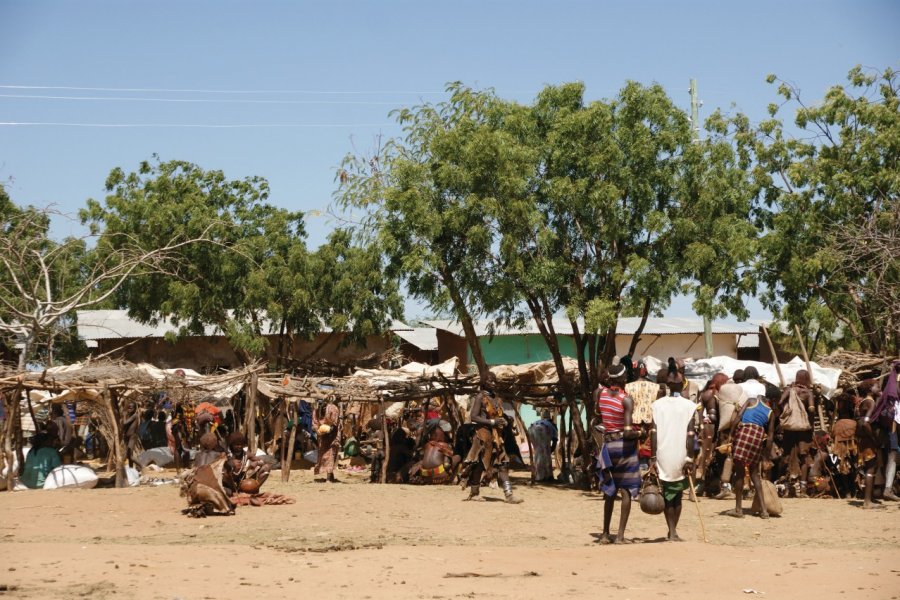Travel Guide Turmi
Find an accommodation
Advertising
Whichever route you choose, we strongly recommend arriving late Monday morning. This market day brings together the Hamer community, who come from the surrounding villages to trade or simply exchange news. In the small, heat-stricken square, where the smell of rancid butter wafts, men, women and children display their finery: short hair adorned with multicolored beads or iron tiaras, long hair coated with butter and clay for the women, braided hair or feathered headdresses for the men, every detail signalling membership of a clan, a group, a family. Faced with this simple, captivating spectacle, the urge to take photos becomes irresistible. However, it's a good idea to be patient, to wait a little while until the small community loses interest in the tourists and, once again absorbed in its transactions, rediscovers its naturalness and the simple gestures of daily life.It's also a good idea to accept the services of a local schoolboy or girl who can help you communicate, take photos and negotiate prices, without forgetting to pay him or her according to the terms agreed together at the time of making contact, or more if the services rendered exceed your expectations. Some of them speak English and know several of the languages used on the market. That's the best way to keep the peace and do good business.Hamer territory. It stretches east from Mago Park to the shores of Lake Stephanie, and is bounded to the north by Bana territory and to the south by the Kenyan border. These agro-pastoralists, estimated at 40,000 individuals, subsist on the cultivation of sorghum, millet, tobacco and cotton and, above all, on livestock farming, which represents the real pillar of their social structure. The abundance of livestock determines a man's wealth and social standing, enabling him to extend his views to several wives. While sexual freedom was total before marriage, afterwards female adultery was severely repressed, while men regularly indulged in extramarital affairs, which were considered perfectly acceptable. At birth, every child is given a cow's name (of which there are more than twenty-five different terms to describe the color of its coat) as well as its first name. Frequently on the move in search of fertile areas, the Hamer attach little importance to material things, preferring to express their aesthetic sense in adornment and body decoration. Valiant men who have defeated an enemy or a wild animal are granted the privilege of wearing complex headdresses for a year, made of colored clay and topped with ostrich feathers. All wear a very short checked loincloth, held in place by old cartridge belts; some have their thighs or calves coated with natural white chalk paint, which, seen from afar, looks like high socks! The women, dressed in cowhide encrusted with pearls and cowries, show scarification and scars, smear their hair with butter and clay, and adorn themselves with voluminous bracelets. Married, they wear three large necklaces, two of metal and one of leather. Hamer culture seems impervious to all outside influences, making them one of the region's most fascinating ethnic groups.The oukouli, passage to adulthood. Among the Hamer, the most important rite is that which accompanies the passage from adolescence to adulthood. After several days of initiation, the novice stands naked before the assembled village. In the middle of the circle where the herd has been gathered, the women, as if hysterical, rub up against the animals, jostling them in a kind of saraband where shouts and trunk blows resound. Soon the men enter the scene and, controlling the animals by their horns and tails, line them up flank to flank. The young boy, impressed, must now prove himself under the watchful eye of his elders. Gaining momentum, he hoists himself onto the backs of the cows and, in one go, traverses the line of protruding spines. The obstacle course is repeated four times, and only one fall is forgiven. Beyond that, it's the ultimate humiliation: beaten by the women, he'll remain the clan's whipping boy for the rest of his life.This ceremony is preceded by another, even more impressive one. Gathered separately, the women of the clan undergo a voluntary flogging session as a sign of support for the future initiate. After long incantatory chants, the girls head for the maz, the whippers armed with small, flexible badines. Immobile in front of the "executioner", arms raised, they wait without flinching for the blow that soon slams into their backs, opening wide, bloody gashes. As if in a trance, some argue, asking again and again to be flogged. Faced with the maz who tries to restrain them, they scream and insult, containing their suffering so that they can show off their lacerated backs to the clan as proof of their courage.Finally, in this stifling atmosphere, a dance begins to bring this violent rite to a close. Adorned with large anklets and bells, the women jump up and down in a cadence punctuated by the steady clatter of clashing finery. Gradually, the tension in the group eases, and soon it's time to join the men, who have been preparing the initiate.
What to visit Turmi?
Advertising
Suggested addresses Turmi
Weather at the moment
Advertising
Organize your trip with our partners Turmi
Transportation
Book your plane tickets
Car Rental
Boat rental
Accommodation & stays
Find a hotel
Holiday rental
Find your campsite
Tailor-made trip
Immersion travel
Services / On site
Activities & visits
Find a doctor








